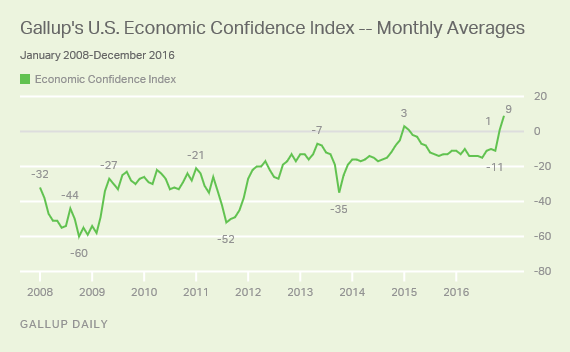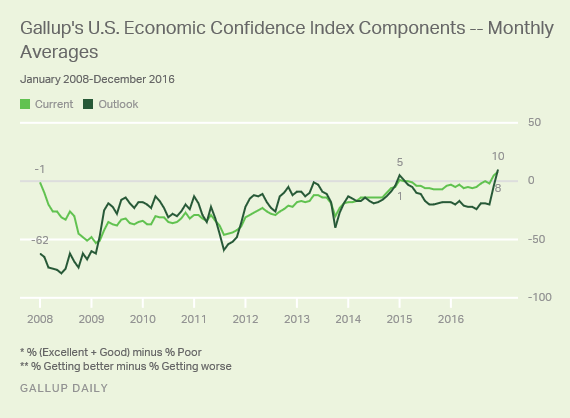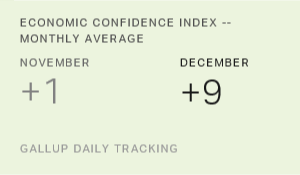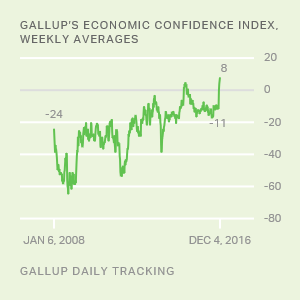Story Highlights
- Index at +9 in December, up eight points from November
- Both index components reach new highs
- GOP has higher confidence than Democrats for first time since '09
WASHINGTON, D.C. -- Americans ended 2016 with higher confidence in the U.S. economy than they have expressed at any other point since 2008. Gallup's Economic Confidence Index averaged +9 in December, up eight points from November.

The record-high confidence is largely the result of increased optimism among Republicans after November's election. Before President-elect Donald Trump's victory, the index score was negative in nearly all weekly and monthly readings Gallup has recorded since 2008.
December's figure of +9 is only marginally better than what Gallup measured in November after the election (+4), but the December average was significantly higher because the November average includes a mixture of pre-election (when the index averaged -11) and post-election interviewing. In other words, confidence did not improve much in December compared with what it was in mid- to late November.
That said, for the final week in December, the index averaged +11, the best weekly average in Gallup's tracking trend.
Gallup's U.S. Economic Confidence Index is the average of two components: how Americans rate current economic conditions and whether they feel the economy is improving or getting worse. The index has a theoretical maximum of +100 if all Americans were to say the economy is doing well and improving, and a theoretical minimum of -100 if all Americans were to say the economy is doing poorly and getting worse.
Americans' assessments of both the current economy and its direction are the most positive they have been since 2008.
In December, 30% of Americans rated the economy as "excellent" or "good," while 22% said it was "poor," resulting in a current conditions score of +8. This was up from November's +5 current conditions score and marks the highest reading for this component since 2008.
Meanwhile, the outlook score was up more sharply, rising to +10 in December from -4 the prior month. The December score, the highest in Gallup tracking since 2008, reflected 52% of Americans saying economic conditions in the country were "getting better," while 42% said they were "getting worse."

Republicans Edge Democrats in Confidence for First Time Since January 2009
With their party's nominee having just won the 2016 presidential election, Republicans' views of the economy have become more favorable. As a result, after lagging Democrats substantially, Republicans (+16) now have slightly higher economic confidence than Democrats (+11). This is the first time Republicans have been more positive than Democrats since January 2009, during another transition period, as Republican President George W. Bush served his final weeks in office.
On the other hand, although it remained positive, Democrats' confidence score slipped from +15 in November to +11 in December. And with independents' confidence rising from -5 to +3, all three party groups now have positive index scores.

Bottom Line
December's relatively high economic confidence results from a shift in views of the ways Republicans and Democrats look at the economy. Republicans gained economic confidence on the heels of the election, while Democrats' confidence began to edge down. These trends could continue once President Barack Obama leaves the White House on Jan. 20, with a yet-to-be-determined effect on overall confidence.
Trump is set to take office at a time of favorable economic conditions across several different measures, from low unemployment to healthy gains in the stock market, which could help him maintain a confidence among Americans early in his presidency. Whether those measures stay strong over the course of his administration will help determine whether Americans continue to evaluate the U.S. economy positively.
These data are available in Gallup Analytics.
Gallup.com reports results from these indexes in daily, weekly, and monthly averages and in Gallup.com stories. Complete trend data are always available to view in the following charts:
Daily: Employment, Economic Confidence, Consumer Spending
Weekly: Employment, Economic Confidence, Job Creation, Consumer Spending
Read more about Gallup's economic measures.
View our economic release schedule.
Survey Methods
Results for this Gallup poll are based on telephone interviews conducted Dec. 1-30, 2016, on the Gallup U.S. Daily survey, with a random sample of 13,674 adults, aged 18 and older, living in all 50 U.S. states and the District of Columbia. For results based on the total sample of national adults, the margin of sampling error is ±1 percentage point at the 95% confidence level. All reported margins of sampling error include computed design effects for weighting.
Each sample of national adults includes a minimum quota of 60% cellphone respondents and 40% landline respondents, with additional minimum quotas by time zone within region. Landline and cellular telephone numbers are selected using random-digit-dial methods.
Learn more about how Gallup Daily tracking works.



